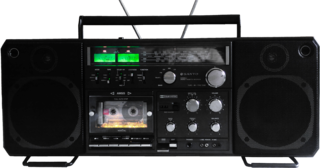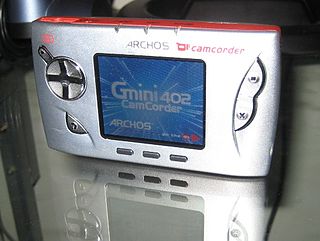
Windows Media Player (WMP) is a media player and media library application developed by Microsoft that is used for playing audio, video and viewing images on personal computers running the Microsoft Windows operating system, as well as on Pocket PC and Windows Mobile-based devices. Editions of Windows Media Player were also released for classic Mac OS, Mac OS X and Solaris but development of these has since been discontinued.

MiniDisc (MD) is a magneto-optical disc-based data storage format offering a capacity of 60, 74 minutes and, later, 80 minutes, of digitized audio or 1 gigabyte of Hi-MD data. Sony brand audio players were on the market in September 1992.

The Compact Cassette, Compact Audio Cassette (CAC) or Musicassette (MC), also commonly called the cassette tape or simply tape or cassette, is an analog magnetic tape recording format for audio recording and playback. It was developed by Philips in Hasselt, Belgium, and released in 1962. Compact cassettes come in two forms, either already containing content as a prerecorded cassette (Musicassette), or as a fully recordable "blank" cassette. Both forms are reversible by the user.

A boombox is a transistorized portable music player featuring one or two cassette tape recorder/players and AM/FM radio, generally with a carrying handle. Beginning in the mid 1980s, a CD player was often included. Sound is delivered through an amplifier and two or more integrated loudspeakers. A boombox is a device typically capable of receiving radio stations and playing recorded music. Many models are also capable of recording onto cassette tapes from radio and other sources. In the 1990s, some boomboxes were available with minidisc recorders and players. Designed for portability, boomboxes can be powered by batteries as well as by line current. The boombox was introduced to the American market during the late 1970s. The desire for louder and heavier bass led to bigger and heavier boxes; by the 1980s, some boomboxes had reached the size of a suitcase. Some larger boomboxes even contained vertically mounted record turntables. Most boomboxes were battery-operated, leading to extremely heavy, bulky boxes.

Monaural or monophonic sound reproduction is sound intended to be heard as if it were emanating from one position. This contrasts with stereophonic sound or stereo, which uses two separate audio channels to reproduce sound from two microphones on the right and left side, which is reproduced with two separate loudspeakers to give a sense of the direction of sound sources. In mono, only one loudspeaker is necessary, but, when played through multiple loudspeakers or headphones, identical signals are fed to each speaker, resulting in the perception of one-channel sound "imaging" in one sonic space between the speakers. Monaural recordings, like stereo ones, typically use multiple microphones fed into multiple channels on a recording console, but each channel is "panned" to the center. In the final stage, the various center-panned signal paths are usually mixed down to two identical tracks, which, because they are identical, are perceived upon playback as representing a single unified signal at a single place in the soundstage. In some cases, multitrack sources are mixed to a one-track tape, thus becoming one signal. In the mastering stage, particularly in the days of mono records, the one- or two-track mono master tape was then transferred to a one-track lathe intended to be used in the pressing of a monophonic record. Today, however, monaural recordings are usually mastered to be played on stereo and multi-track formats, yet retain their center-panned mono soundstage characteristics.

A USB flash drive, also known as a thumb drive, pen drive, gig stick, flash stick, jump drive, disk key, disk on key, flash-drive, memory stick, USB key, USB stick or USB memory, is a data storage device that includes flash memory with an integrated USB interface. It is typically removable, rewritable and much smaller than an optical disc. Most weigh less than 1 oz. Since first appearing on the market in late 2000, as with virtually all other computer memory devices, storage capacities have risen while prices have dropped. As of March 2016, flash drives with anywhere from 8 to 256 GB were frequently sold, while 512 GB and 1 TB units were less frequent. As of 2018, 2TB flash drives were the largest available in terms of storage capacity. Some allow up to 100,000 write/erase cycles, depending on the exact type of memory chip used, and are thought to last between 10 and 100 years under normal circumstances.
In computing, mass storage refers to the storage of large amounts of data in a persisting and machine-readable fashion. Devices and/or systems that have been described as mass storage include tape libraries, RAID systems, and a variety of computer drives such as hard disk drives, magnetic tape drives, magneto-optical disc drives, optical disc drives, memory cards, and solid-state drives. It also includes experimental forms like holographic memory. Mass storage includes devices with removable and non-removable media. It does not include random access memory (RAM).

In January 2004, Sony announced the Hi-MD media storage format as a further development of the MiniDisc format. With its release in later 2004, came the ability to use newly developed, high-capacity 1 gigabyte Hi-MD discs, sporting the same dimensions as regular MiniDiscs. The Hi-MD format can be considered obsolete as the last recorder/player was discontinued in 2011. The discs themselves were withdrawn from sale in September 2012, though regular MiniDiscs are still available.

In computing, a file system or filesystem controls how data is stored and retrieved. Without a file system, information placed in a storage medium would be one large body of data with no way to tell where one piece of information stops and the next begins. By separating the data into pieces and giving each piece a name, the information is easily isolated and identified. Taking its name from the way paper-based information systems are named, each group of data is called a "file". The structure and logic rules used to manage the groups of information and their names is called a "file system".
A portable audio player is a personal mobile device that allows the user to listen to recorded audio while mobile. Sometimes a distinction is made between a portable player, battery-powered and with one or more small loudspeakers, and a personal player, listened to with earphones.

A portable media player (PMP) or digital audio player (DAP) is a portable consumer electronics device capable of storing and playing digital media such as audio, images, and video files. The data is typically stored on a CD, DVD, BD, flash memory, microdrive, or hard drive. Most portable media players are equipped with a 3.5 mm headphone jack, which users can plug headphones into, or connect to a boombox or hifi system. In contrast, analogue portable audio players play music from non-digital media that use analogue signal storage, such as cassette tapes or vinyl records.

Mini CDs, or pocket CDs, are CDs with a smaller diameter and one third the storage capacity of a standard 120 mm disc.
Hierarchical storage management (HSM) is a data storage technique that automatically moves data between high-cost and low-cost storage media. HSM systems exist because high-speed storage devices, such as solid state drive arrays, are more expensive than slower devices, such as hard disk drives, optical discs and magnetic tape drives. While it would be ideal to have all data available on high-speed devices all the time, this is prohibitively expensive for many organizations. Instead, HSM systems store the bulk of the enterprise's data on slower devices, and then copy data to faster disk drives when needed. In effect, HSM turns the fast disk drives into caches for the slower mass storage devices. The HSM system monitors the way data is used and makes best guesses as to which data can safely be moved to slower devices and which data should stay on the fast devices.
A skip occurs when a phonograph (gramophone), cassette tape or Compact Disc player malfunctions or is disturbed so as to play incorrectly, causing a break in sound or a jump to another part of the recording.

Yepp was Samsung Electronics' digital audio player brand until Samsung decided to retire most of their family brands in February 2011. From then on, their MP3 players were simply branded "Samsung" worldwide until they discontinued all of them late 2013. The brand included a wide range of hard-drive based as well as flash-memory based players. The name is claimed to be an acronym for "young, energetic, passionate person".

Delay is an audio effect and an effects unit which records an input signal to an audio storage medium, and then plays it back after a period of time. The delayed signal may either be played back multiple times, or played back into the recording again, to create the sound of a repeating, decaying echo.

The Gmini is a series of portable audio and video players released by Archos in 2004 and 2005.

Style Jukebox was a hi-fi high-resolution audio cloud music streaming and storage player for the Windows, iOS, Android and Windows Phone platforms. A Web Player is also available for Mac, Windows and Linux.
Sideloading is a term used mostly on the Internet, similar to "upload" and "download", but in reference to the process of transferring files between two local devices, in particular between a computer and a mobile device such as a mobile phone, smartphone, PDA, tablet, portable media player or e-reader.

















